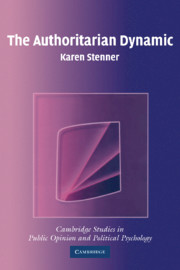Book contents
- Frontmatter
- Contents
- List of Tables
- List of Figures
- Acknowledgments
- 1 Introduction: The Authoritarian Dynamic
- 2 Kindred Spirits, Common Spark: The Theory of the Authoritarian Dynamic
- 3 Manipulating Threat and Reassurance: Data and Methods
- 4 The Authoritarian Dynamic and the Politics of Fear: Putting the Pieces of the Puzzle Together
- 5 Authoritarianism and Conservatism across Cultures
- 6 Authoritarianism and Conservatism: How They Differ and When It Matters
- 7 One True People: Putting a Face on the Theory
- 8 One Right Way: Fleshing Out the Portrait
- 9 Manning the Barricades: Racism and Intolerance under Conditions of Normative Threat
- 10 The Authoritarian Dynamic: Implications
- Bibliography
- Index
- Titles in the series
6 - Authoritarianism and Conservatism: How They Differ and When It Matters
Published online by Cambridge University Press: 05 June 2012
- Frontmatter
- Contents
- List of Tables
- List of Figures
- Acknowledgments
- 1 Introduction: The Authoritarian Dynamic
- 2 Kindred Spirits, Common Spark: The Theory of the Authoritarian Dynamic
- 3 Manipulating Threat and Reassurance: Data and Methods
- 4 The Authoritarian Dynamic and the Politics of Fear: Putting the Pieces of the Puzzle Together
- 5 Authoritarianism and Conservatism across Cultures
- 6 Authoritarianism and Conservatism: How They Differ and When It Matters
- 7 One True People: Putting a Face on the Theory
- 8 One Right Way: Fleshing Out the Portrait
- 9 Manning the Barricades: Racism and Intolerance under Conditions of Normative Threat
- 10 The Authoritarian Dynamic: Implications
- Bibliography
- Index
- Titles in the series
Summary
In the preceding chapter, I sought to distinguish authoritarianism from status quo conservatism by exploiting cross-national data to reveal their varying influence on intolerance, viewed in the context of variations in cultural traditions. This chapter will continue to pursue the overarching objective of distinguishing authoritarianism from conservatism, but this time devoting just a little more attention to discerning the differences between authoritarianism and laissez-faire conservatism, and to assessing their relative influence on intolerance in contemporary American politics. While the notion received no general support from the cross-national data investigated in Chapter 5, the idea that aversion to government intervention in the economy is somehow implicated in intolerance is especially entrenched in U.S. politics and political science. It ought to be explored using U.S. data, the conceptualizations and measures favored by U.S. political science, and the targets and forms of intolerant expression characteristic of U.S. politics.
Inevitably, this will be done at some cost to conceptual clarity, since the way in which the notion of “conservatism” is typically employed in American politics, and conceived and measured in American political science, hopelessly entangles those three dimensions we have so far striven to distinguish: authoritarianism, status quo conservatism and laissez-faire conservatism. Still, we have other data available to us with measures that cleanly distinguish the three predispositions, and sufficient cross-national variation in the alignment of those dimensions to separate out their influence.
- Type
- Chapter
- Information
- The Authoritarian Dynamic , pp. 138 - 198Publisher: Cambridge University PressPrint publication year: 2005



